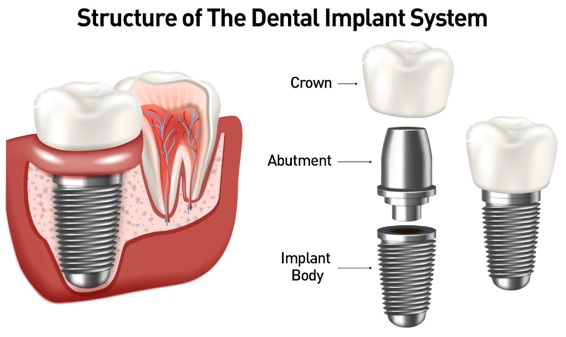The Of Dental Implants
Table of ContentsGetting My Dental Implants To WorkUnknown Facts About Dental ImplantsThe Single Strategy To Use For Dental ImplantsGetting My Dental Implants To Work
are medical gadgets operatively dental implanted right into the jaw to recover an individual's ability to chew or their look. They provide support for synthetic (fake) teeth, such as crowns, bridges, or dentures. When a tooth is lost as a result of injury or illness, a person can experience issues such as fast bone loss, defective speech, or modifications to eating patterns that cause pain.
Structure of The Oral Implant System choosing dental implants, speak to your dental service provider about the possible advantages and risks, and whether you are a prospect for the procedure. Points to think about: Your total wellness is a vital consider determining whether you are an excellent candidate for dental implants, the length of time it will certainly take to recover, and for how long the dental implant may remain in area.
Smoking might impact the healing process and decrease the lasting success of the implant. The healing process for the implant body might take numerous months or longer, during which time you generally have a short-term abutment in area of the tooth. the dental implant treatment: Carefully follow the dental hygiene guidelines given to you by your oral supplier.
What Does Dental Implants Do?
Implant failing can result in the need for another medical procedure to repair or replace the implant system. Brings back the ability to eat Brings back cosmetic appearance Aids keep the jawbone from diminishing as a result of bone loss Preserves the health and wellness of the surrounding bone and periodontals Aids maintain nearby (neighboring) teeth stable Enhances high quality of life Damage to bordering all-natural teeth during implant placement Injury to the surrounding cells throughout surgery, such as sinus perforation Injury during surgery (as an example, fracture of surrounding jawbone) Inadequate feature, such as feeling like the teeth do not bite together typically An experience that the tooth hangs or turning in position resulting from a joint screw loosening up Implant body failure (looseness of the dental implant body) as a result of systemic infection, which may be more probable in individuals with unrestrained diabetes mellitus due to regional infection in bone and periodontals sustaining the implant body because of postponed recovery, which might be more likely in clients that smoke Difficulty cleaning the gums around the dental implant, causing bad dental health Unattended gum condition Post-surgical tingling as a result of nerve impingement or damages Constantly inform health and wellness treatment companies and imaging technicians that you find out this here have oral implants before any magnetic resonance imaging (MRI) or x-ray treatments.
FDA is not knowledgeable about any type of unfavorable events Dental Implants reported for MRI or x-ray procedures with oral implants. Dental implants systems are usually made of products that adhere to international agreement standards of the International Organization for Standardization (ISO) or ASTM International. These requirements have details of what makes a safe material.
Various other materials such as gold alloys, cobalt-based alloys, titanium alloys, or ceramic products are sometimes utilized. The security accounts of these products are well-known. Oral implant systems are examined according to global consensus criteria. Biocompatibility testing, to reveal that bodily call with the gadget does not create problems like irritation or allergic response, becomes part of the evaluation that assists make sure the materials in the oral implant system are risk-free and do not trigger adverse results when dental implanted in people.

The Main Principles Of Dental Implants
Some people are not qualified for dental implant surgical procedure. It is for oral doctors to operate individuals with: acute illnessuncontrollable metabolic diseasebone or soft cells illness or infectionIf these issues are settled, a person can have the surgical treatment. Dental Implants. In, dental specialists refrain from running on people with: If individuals read review with any of the above undertake oral implant surgery, there is a greater danger of the implant falling short
Some individuals have a jawbone abnormality that protects against adequate bone for an implant from developing. The surgeon will certainly after that make use of a bone or bone alternative to repair and build up the location.
Oral dental implant surgical procedure is a customized procedure. Offer you time to recover. Attach the blog post and final crown, bridge or denture.
Next, your specialist will carefully place the oral implant right into your jaw. Your surgeon will reposition your gums and close the incision with stitches (Dental Implants). If your implant is near the front of your mouth, your dental practitioner will certainly make a short-term tooth for you to put on until you recover. That means, you won't have a gap in your smile while you recover.
Things about Dental Implants
Your provider can inform you what to anticipate in your scenario. During the recovery phase, your jawbone needs to fuse to the oral implant. This procedure, called osseointegration, is critical for security and long-term success. This process can take anywhere from three to nine months. In some situations, it may take longer.
Once your dental implant heals, your dental practitioner can affix the joint (small port blog post) and your final reconstruction (crown, bridge or denture). This usually takes about one hour to finish and may require a 2nd minor surgery. You should not feel any pain during your oral implant procedure due to the fact that your company will make use of medication to numb your periodontals.